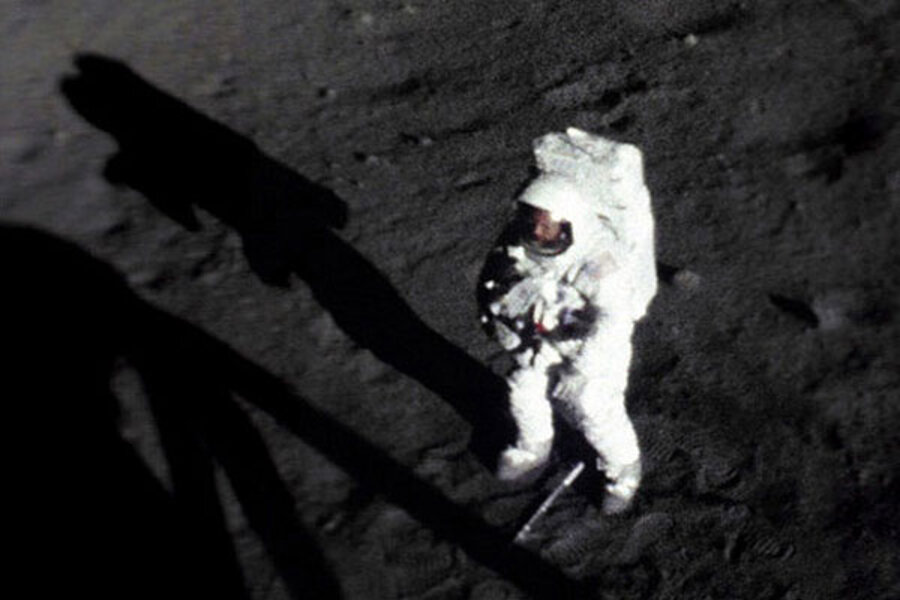Astronauts, family remember Neil Armstrong
Loading...
| Cincinnati
Neil Armstrong was a humble hero who saw himself as a team player and never capitalized on his celebrity as the first man to walk on the moon, mourners said Friday outside a private service attended by fellow space pioneers, including his two crewmates on the historic Apollo 11 mission.
Hundreds of people attended a closed service for Armstrong Friday at a private club in suburban Cincinnati. A national memorial service has been scheduled for Sept. 12 in Washington, although no other details have been released on the service or burial plans for Armstrong. He died Saturday at age 82.
Among some 10 former astronauts attending Friday were John Glenn and Armstrong's crew for the 1969 moon landing, Buzz Aldrin and Michael Collins.
"You'll never get a hero, in my view, like Neil Armstrong," said Apollo 8 astronaut Bill Anders, who praised Armstrong after the service for his wisdom and humility in the way he handled becoming a global icon. "It's going to be hard to top."
"America has truly lost a legend," said Eugene Cernan, an Apollo astronaut who is the last man to have walked on the moon.
Sen. Rob Portman, an Ohio Republican, eulogized Armstrong "as a reluctant hero" and said afterward the service was a mix of emotion and humor, with Armstrong's two sons talking about him as a father and grandfather.
"He touched the lives of so many," Portman said.
"He was the embodiment of everything this nation is all about," said NASA Administrator Charles Bolden. Armstrong, he said, had a courageous drive for exploration while being an "incredibly humble" man who probably wouldn't have wanted all the attention of Friday's service.
It included a Navy ceremonial guard, a bagpiper corps and songs including "When the Saints Go Marching In." Four Navy fighter planes flew over at the end of the service, one flying upward in tribute to Armstrong, a former Navy pilot who flew combat missions in Korea.
Raised in Wapakoneta, Ohio, Armstrong developed an early love for aviation.
He commanded the Gemini 8 mission in 1966 and Apollo 11's historic moon landing on July 20, 1969. As a worldwide audience watched on TV, Armstrong took the step on the lunar surface he called "one giant leap for mankind."
Juri Taalman, 78, said he made a special trip from Hartford, Conn., just to stand across the road from the club where the service was held, in tribute to Armstrong.
He said he and his wife were on their honeymoon in Amsterdam the day of the moon landing. He recalled hotel employees bringing champagne to the guests watching Armstrong's first steps together on television, and an Englishman lifting his glass in a toast "to all mankind!"
Taalman's voice cracked as he discussed his visit Friday.
"I just think a really great man has passed, and the world is poorer for it," he said.
Earlier Friday, Cernan and Apollo 13 commander James Lovell spoke at a Cincinnati hospital to help launch a children's health fund in Armstrong's memory.
Cernan and Lovell recounted visiting U.S troops in Iraq and Afghanistan with Armstrong, saying he always had an inspirational impact when meeting troops, schoolchildren and other admirers around the world.
Lovell said Armstrong was "a great American" who never capitalized on his celebrity and just "wanted to be a team player." While Armstrong had said any of the astronauts could have been the first to walk on the moon, Lovell and Cernan said Armstrong was the right choice because of the way he handled suddenly becoming an icon.
"There's nobody that I know of that could have accepted the challenge and responsibility that came with being that with more dignity than Neil Armstrong," Cernan said.
Lovell and Cernan said that they had visited Armstrong two months ago in his home in suburban Indian Hill, and that he cooked breakfast for them — and burned the eggs.
"Neil Armstrong was probably one of the most human guys I've ever known in my life," Cernan said.
Armstrong's family has suggested memorial contributions to two scholarship funds in his name or to the Neil Armstrong New Frontiers Initiative at Cincinnati Children's. His wife, Carol, is on the hospital's board.
The astronauts were joined there Friday by 14-year-old Shane DiGiovanna, an aspiring aerospace engineer with a rare skin tissue disease. He is able to hear after a cochlear implant, with a device developed by a NASA scientist.
Before the announcement, Shane, who said Armstrong has always inspired him, quizzed the two astronauts about details of their missions. Lovell recounted the streams of oxygen that wrapped the Apollo 13 spacecraft "like a cocoon" after an oxygen tank explosion. The harrowing Apollo 13 flight was recounted in his book and depicted in the popular movie, in which Tom Hanks played Lovell.
After his space career, Armstrong returned to Ohio, teaching aerospace engineering at the University of Cincinnati and generally avoiding public view for most of the rest of his life.
Armstrong married Carol Knight in 1999. He had two sons from a previous marriage.
In announcing his death, Armstrong's family requested that when people "see the moon smiling down at you, think of Neil Armstrong and give him a wink."







